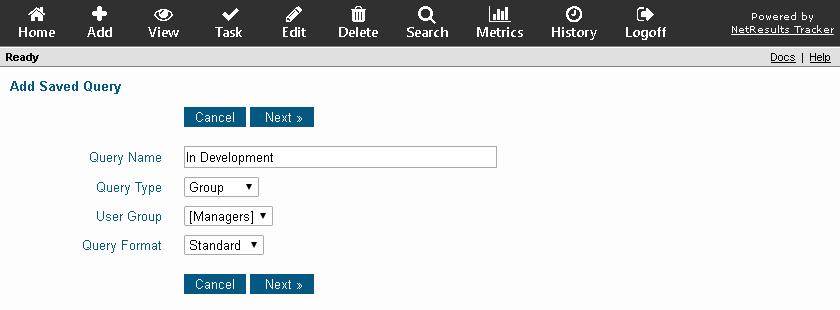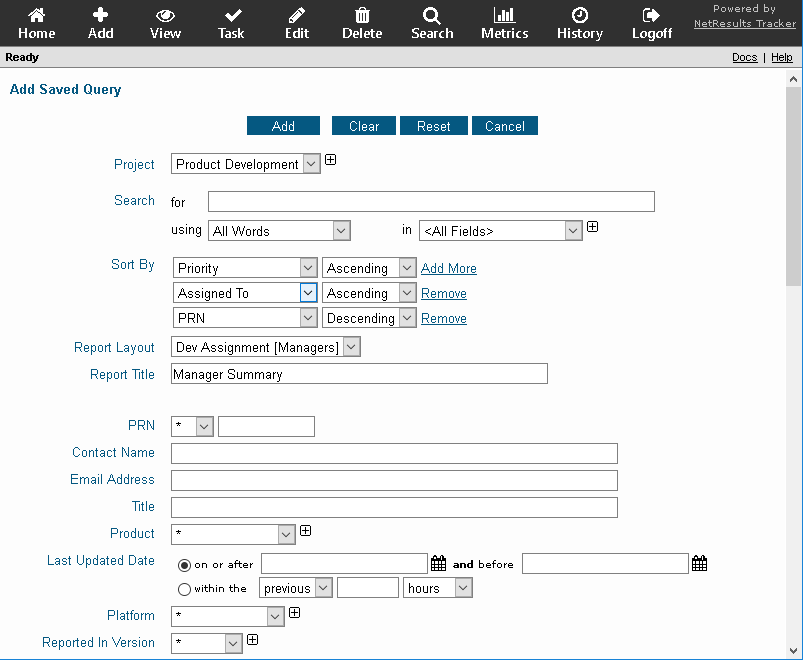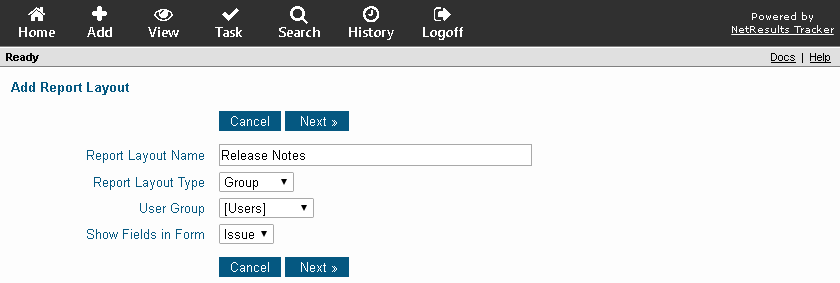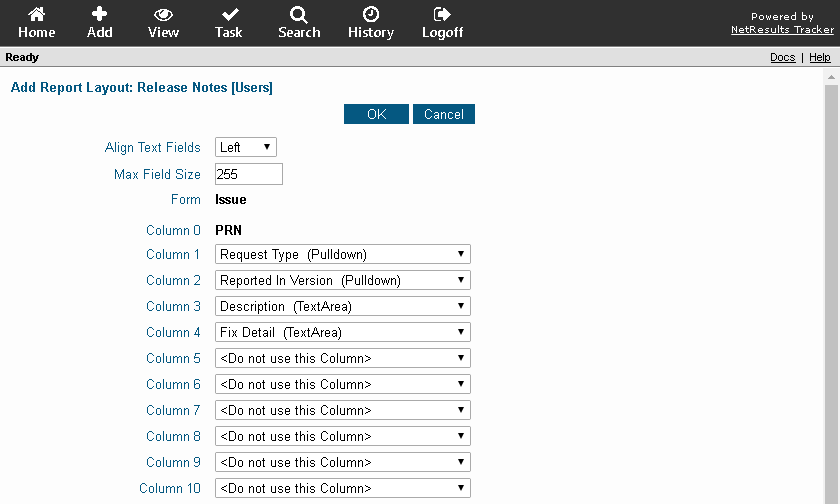 NetResults Tracker Help NetResults Tracker Help |
 |
|
|
Using Saved Queries and Reports |  | | |
A Tracker report is composed of the search criteria, which is
called a query,
and a report layout for the results, which determines which fields are displayed in the
results and other options. You can define and save
both queries and report layouts. This enables you to
quickly select from a list of frequently used queries, rather than
re-entering all the query parameters for each query.
You can use either group or personal saved queries. You can
always save a personal query, and if you have been given
permission by your Administrator, you may also be able to
save a query or report layout for use by all users in your assigned
user group(s).
Saved Queries Bar
Saved queries
are managed by the Saved Query bar which appears on
the Search Page below the status bar, as shown below:

Using the Saved Query bar, you can define new queries, edit or remove
existing saved queries, run or preview a saved query and set a default saved
query. Group level
saved queries are listed followed by the User Group name in square
brackets (e.g. "Assigned to Me [Users]" denotes
the saved report called "Assigned to Me" is accessible by the user group "Users").
Admin users can access saved queries for all user groups
without having to be a member of each group.
Report Layouts Bar
Saved report layouts
are managed by the Report Layouts bar which also appears on
the Search Page below the status bar, as shown below:

Using the Saved Reports bar, you can define new report formats,
and edit or remove existing saved report formats. Group level
saved report formats are listed followed by the User Group name
in square brackets.
Admin users can access saved reports for all user groups
without having to be a member of each group.
If a user group is not available for selection, you may not be a member of the user
group or you may not have sufficient privileges for saving reports or report layouts for that
user group. If you are a member of the user group or are logged in as a user
with the Admin privilege, the user group may not have visibility to at least one
Project and Form. Only user groups that have visibility to at least one Project
and Form (configured in the Admin section) will be available for selection when
creating group saved queries, advanced queries or report layouts.
Topics Covered In This Section
Restrictions on Saving Queries and Layouts
In order to create a saved query or report layout for a user group, a user must have
the necessary privileges as defined by your Tracker Administrator.
Without these privileges, a user can only create personal saved
queries and report layouts.
Depending on the user group privileges that have been assigned to your by your
Tracker Administrator, you may only be able to use certain
operations on certain saved group reports or report layouts. For example, if you are a member of 2 user groups,
but only have privileges to edit group saved reports or report layouts for one of those user groups,
some of the operations in the Saved Queries or Report Layouts bar (e.g. "Add", "Edit") may be disabled
when selecting a saved query or report layout for a group where you have limited privileges.
Return to Topics List
The Effects of Field Visibility
Field Visibility is the feature that allows fields to be restricted by user
group in various areas of Tracker such as the Add, Edit,
and View pages and in Queries and Reports. That is to say that
the system can be configured such that each user group may see a different set of fields
in each area of Tracker. Therefore, when creating saved group
queries and report layouts, all fields may not be displayed depending on field visibility
settings for the group selected.
When a field is not visible to the user group selected in a saved group query,
the field will be set to the default value when the saved group query is run. In most cases,
this default value is "*", which will include all possible values for the field in the saved group
query results.
In the case of the Deleted field, the default is "No" such that all records that have not been
marked as deleted will be included in the results of the saved group query.
In the case of report layouts, if the field is not visible to the group selected for
the saved group report layout, the field will not appear in the list of possible values
for each column of the report.
Please contact your Tracker Administrator if you wish to include a field in a saved
group query or report layout that is not visible to the selected user group.
Return to Topics List
Multiple Forms
Saved Queries and Report Layouts with multiple forms selected can have fields
selected in the criteria that are not available in all forms (the field does not exist in certain
forms) or are not visible to all
user groups who are able to run that saved query or report layout. When this occurs,
the criteria that does not apply to a certain form will not match any records for that
form. For example, let's say there are 2 forms in a workgroup: Form A and Form B.
There is a query with Form = "*" (records that match either Form A or
Form B) and "Priority = 1", but Priority is not visible in Form A.
Since Priority is not visible in Form A, no records added using Form A will be included in
the query results (because there are no records added using Form A that have the Priority field set).
The same is true for report layouts. This means that if a field is not visible or does not exist in a form,
no value will be displayed in that field's column for records where the field is not visible or does not exist.
Using a similar example the one above for query results (query with Form = "*", which
will return records that match either Form A or Form B, Priority is not visible in Form A).
The report layout we are using with this query has a column with "Priority" selected. In
the query results any records added using Form A will have a blank value in the Priority column.
Return to Topics List
Add a Saved Query
To add a saved query, follow these steps:
- Login to the
workgroup
- Click on the Search icon in the Button bar
- Click on the Add button to the right of the Saved Queries pulldown.
Note: to create a
Saved Query that is similar to an existing Saved Query, select the
existing saved query in the pulldown menu to the left before clicking
the Add button.

- Enter a name for the saved query in the Query Name field
(this is the name that
you will use to retrieve the query)
- In the Query Type field, select whether this is a "Personal" (to
create a saved query that will be accessible only to you) or "Group"
(to create a saved query that will accessible to members
of a particular user group) saved query.
- If you selected "Group" as the Query Type,
select a user group in the User Group field to which this saved query should be visible.
You will only be able to select the user groups in which you are a
member (however, the Tracker Administrator
can add saved queries for any user group).
- Select "Standard" as the Query Format and click Next to proceed

- If you have access to multiple projects and/or forms, the Project
and Form fields will be displayed. By default, "*" will be selected to match any project or form.
To select multiple values, hold down the Ctrl button on your keyboard while clicking on each desired value.
If specific forms are selected, a Get Fields button will appear. Click on it to update the list of available fields for selecting query criteria.
- You can perform a full text search by entering a key word(s) or phrase in the Search section "for" box. Then, select a search method in "using". By default, the search will be done across "<All Fields>". Or, you can expand the "in" option to select specific fields to be included in the search.
For more detail about the fields included or the search methods used, please review the Full Text Search section.
- Choose how the results will be sorted in the Sort By section.
Select a field to sort by, then choose Ascending or Descending
as the sort order. Link and TextArea type fields are not available as sort options.
To add another level of sorting, click on the Add More link. Up to 4 fields can be selected for sorting. Or, click the Remove to remove a sort option.
Please note:
- When the preference
Exclude Time From Reports is enabled and a Date field is selected in the
Sort By section, the query results will be sorted by the time in each record
even though the results will not include the time information.
- When PRN (Record ID) is selected
for one of the Sort By fields, the records will be ordered according to the numeric component of
the PRN (Record ID) field. The short name of the form will not be used as part of the sorting when
PRN (Record ID) is selected. For example, let's say you have PRNs "REC1" and "REC2". The sorting
will be done using "1" and "2", ignoring the "REC".
- Select a value in the Report Layout pulldown.
The report layout determines which fields will be displayed
in the columns of the query results.
- The name you entered for Query Name on the previous page will be used as the title by default. If you wish to use something different, enter a title in the Report Title field.
- If you are only using the full text search option, click on the Add button to save the query. Or, you can continue to the next section and select criteria using the list of fields.
You can combine any or all of the fields displayed
to define a query. Each value is applied to the query
as an AND clause, that is, the query will return all records that
match all of the specified criteria. Review the Selecting Query Criteria by Field Type section
for details about how to select criteria in the different field types. After making selections to specific fields, click on the Add button to save the query.
Return to Topics List
Run a Saved Query
To run a saved query, follow these steps:
- Login to the
workgroup
- Click on the Search icon in the Button bar
- In the Saved Queries pulldown at the top of the page, select the saved query you wish to
run
- Click on the Run button to the right of the Saved Queries pulldown
Return to Topics List
Preview a Saved Query
Sometimes you may wish to verify the criteria of
a saved query before running it or perhaps modify it slightly
before running it. The Tracker saved query Preview
feature allows you to do this.
To preview, optionally modify, and run a saved query, follow
these steps:
- Login to the
workgroup
- Click on the Search icon in the Button bar
- In the Saved Queries pulldown at the top of the page,
select the saved query you wish to preview
- Click on the Preview button to the right of the
Saved Queries pulldown
- The criteria and other parameters
for the saved query appear in the query dialog below.
Modify the query criteria or parameters, if desired.
- Click on the Run Query button in the query dialog to run
the query
Return to Topics List
Select a Default Saved Query
To set the query which you would like to appear in the Saved
Queries pulldown when you first browse to the Search page, follow these steps:
- Login to the
workgroup
- Click on the Search icon in the Button bar
- In the Saved Queries pulldown at the top of the page,
select the saved query you wish to save as the default
- Click on the Set as Default button to the right of the Saved Queries
pulldown. The page will be refreshed
and the Status will say "Default Query has been updated.".
Return to Topics List
Edit a Saved Query
To edit a saved query, follow these steps:
- Login to the
workgroup
- Click on the Search icon in the Button bar
- In the Saved Queries pulldown at the top of the page,
select the saved query you wish to edit
- Click on the Edit button to the right of the Saved Queries
pulldown.
- A page containing
the current query criteria and other parameters is displayed.
Edit the query criteria or parameters as desired.
- Click on the OK button to save your updates.
Return to Topics List
Delete a Saved Query
To delete a saved query, follow these steps:
- Login to the
workgroup
- Click on the Search icon in the Button bar
- In the Saved Queries pulldown at the top of the page,
select the saved query you wish to delete
- Click on the Delete button to the right of the
Saved Queries pulldown
If a user has the saved query you are attempting to delete selected
as one of their default Home Page reports, you will be prompted to confirm that you want to delete
the saved query. Deleting the saved query will remove the it from the Home Page of users that had it selected.
Return to Topics List
Standard Saved Queries within Tracker
Within Tracker, there are saved queries that are installed by default.
The description of each report below is how the saved queries are set by default, but
your Tracker Administrator or another user with the appropriate privileges may have
changed the report's settings:
- Default [Users]: A saved query for the Users group that will display all records within Tracker.
- Assigned to Me [Users]: A saved query for the Users group that will display all records assigned to the user who
is currently logged into Tracker. By default, this query is selected as the First
Home Page Report in the Preferences page for all non-Restricted users. Please review the
Preferences section for more information about selecting a
saved query for the First Home Page Report.
- Reported By Me [Users]: A saved query for the Users group that will display all records reported by the user who
is currently logged into Tracker. By default, this query is selected as the Second
Home Page Report in the Preferences page for all non-Restricted users. Please review the
Preferences section for more information about selecting a
saved query for the Second Home Page Report.
- Added By Me [RestrictedUsers]: A saved query for the RestrictedUsers group that will display all records
reported by the restricted user who is currently logged into Tracker.
By default, this query is selected as the First Home Page Report in the
Preferences page for all Restricted users. Please review the
Preferences section for more information about selecting a
saved query for the First Home Page Report.
Return to Topics List
Report Layouts
Report Layouts determine which fields will be displayed in the query results.
You can create as many report layouts as desired. Report Layouts can be
created for personal use or for use by user groups. When running an ad-hoc query
and when saving queries, you can choose which report layout should be used to
display the query results.
To add a report layout, follow these steps:
- Login to the
workgroup
- Click on the Search icon in the Button bar
- Click on the Add button to the right of the
Report Layouts pulldown

- Select the Report Layout Type. If it's a group report layout, select a
group to which this report layout should be visible.
You will only be able to select the user groups in which you are a
member (however, the Tracker Administrator
can add report layouts for any user group).
Select the form which contains the fields you want to choose from to build the report layout or select "<All>" to
list all fields irrespective of the form in the Show Fields in Form field. If you only have access to one form,
the Show Fields in Form field will not be available.
Click Next to proceed.

- In the form that appears, enter a report name (this is the name
that you will use to select the report layout) in the Report Layout Name field
- Select how to align text fields (left, center, right)
- Set the Max Field Size, which is the maximum number of characters that should be displayed when Text or TextArea fields are included in the layout.
- Select the fields you would like displayed. For reports that will be displayed on the Home Page, it is
recommended that you choose a maximum of 5 or 6 fields to keep the dashboard from getting too crowded with information. The search option available on the Home Page reports can search within all fields in the record so that it's not necessary to have a lot of fields in the report layout.
- Click on the OK button. Now you can use the layout when running an ad-hoc query or add the layout to a saved query.
Return to Topics List
Properties of Fields in Report Layouts
Any of the active fields for the form selected (or all if "<All>" was selected)
can be selected as columns in a report layout.
Some field types have special properties when included in
a report layout.
When the Assigned To or Reported By fields appear in a report layout,
users with the privilege "View User Information" will be able to click on the
user's name in the query results to display the user's profile information (e.g.
phone number, email address, company name).
When the preference Exclude Time
From Reports is enabled and a Date field is included in a report layout,
only the date information (not the time) will be included in the query results.
Selecting a Link field as a column in a report layout will display the PRNs
of any linked records. The PRN for the linked records is a clickable link that will display
the View Page of that record.
Selecting <Attachments> as a column in a report layout will display
the description of any attachments for the record. The description is a link that
can be clicked to view the attachment in a separate browser window.
Selecting <Clone> as a column in a report layout will display "Yes" if a
record is a clone or
"No" if a record is not a clone.
Selecting <Parent PRN> as a column in a report layout will display
the PRN of the record it was cloned from (the parent record). For records
that are not clones, this column will display the value "-1" to signify the
record does not have a parent.
Return to Topics List
Edit a Report Layout
To edit a report layout, follow these steps:
- Login to the
workgroup
- Click on the Search icon in the Button bar
- In the Report Layouts pulldown, select the
report layout you wish to edit
- Click on the Edit button to the right of the Report Layouts
pulldown
- A page containing
the current layout is displayed.
Edit the layout as desired. For reports that will be displayed on the Home Page, it is
recommended that you choose a maximum of 5 or 6 fields to keep the dashboard from getting too crowded with information. The search option available on the Home Page reports can search within all fields in the record so that it's not necessary to have a lot of fields in the report layout.
- Click on the OK button to save your updates
Return to Topics List
Delete a Report Layout
To delete a report layout, follow these steps:
- Login to the
workgroup
- Click on the Search icon in the Button bar
- In the Report Layouts pulldown, select the
report layout you wish to delete
- Click on the Delete button to the right of the Report Layouts pulldown
Return to Topics List
Select a Report Layout in an Ad-hoc Query
To run an ad-hoc query using a particular report layout, follow these steps:
- Login to the
workgroup
- Click on the Search icon in the Button bar
- Enter the query
directly or start with an existing saved query by selecting it in the
Saved Queries pulldown, then clicking on the Preview button.
- Select the report layout wish to use in the Report Layout pulldown
in the Query dialog section (below the Run Query button)
- Click on the Run Query button
Return to Topics List
Save a Report Layout in a Saved Query
To save a report layout in a saved query, follow these steps:
- Login to the
workgroup
- Click on the Search icon in the Button bar
- Select the saved query in the Saved Queries pulldown, then click on the
Edit button to the right of the Saved Queries pulldown.
- In the Report Layout pulldown, select the desired
report layout.
- Click on the OK button to save the change
Return to Topics List
Standard Report Layouts within Tracker
Within Tracker, there are report layouts that are installed by default.
The description of each report layout below is how each is set by default, but
your Tracker Administrator or another user with the appropriate privileges may have
changed the report layout's settings::
- Default [Users]: A report layout for the Users group. The saved query Default [Users] uses this report layout by default.
- Home Report1 [Users]: A report layout for the Users group. By default, this report layout is used by the saved query "Assigned To Me [Users]".
- Home Report2 [Users]: A report layout for the Users group. By default, this report layout is used by the saved query "Reported By Me [Users]".
- Added By Me [RestrictedUsers]: A saved report for the RestrictedUsers group. By default, this report layout is used by the saved query "Added By
Me [RestrictedUsers]".
Return to Topics List
NetResults Tracker © 1997-2020 NetResults Corporation. All rights reserved.





